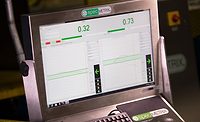NEI Announces New Coatings Patents

SOMERSET, NJ – NEI Corp. announced that the U.S. Patent and Trademark Office has issued patents to the company on self-healing, superhydrophobic and abrasion-resistant coatings.
There is great interest in functional coatings, for both industrial and consumer applications, when the coating or surface treatment provides functionalities beyond the usual protective and aesthetic properties. For example, self-healing coatings autonomously repair damage, hydrophobic coatings are able to vigorously repel water droplets, oleophobic coatings prevent oil molecules from sticking to the surface, and self-cleaning or easy-to-clean coatings minimize or eliminate the need for chemicals during washing. Commercial products to date have met with limited success because they are not engineered to meet all of the functional performance requirements that an application may need. NEI’s patented and patent-pending technologies address this market need.
In the recent past, NEI has introduced several coatings under the registered trade name NANOMYTE®. For example, NANOMYTE MEND is based on U.S. Patent 8,987,352, where a thermally induced physical self-healing phenomenon leads to gap closing and crack sealing. The self-healing coating involves a unique phase-separated morphology that facilitates the delivery of the self-healing agent to the damage site (such as a scratch or crack) thereby restoring the coating appearance and function. In response to the need for waterborne, self-healing coatings for non-metallic substrates, NEI has developed a waterborne, polyurethane-based, self-healing coating (U.S. Patent 8,664,298). A more recent patent-pending version of MEND, referred to as MEND-RT, allows self-healing at near ambient temperature. It is used as the inter-layer of a coating stack and has been shown to enhance the corrosion resistance of traditional coating systems. The MEND coating platform is based on polyurethane, but the principle can be applied to other coating systems as well.
Self-healing principles can also be applied to surface treatments of metals, whereby the pretreatments can mimic the performance of chromate conversion coatings. To this end, NEI has developed a series of pretreatments for different metals where a chemical self-healing mechanism imparts corrosion resistance. For example, NANOMYTE PT-60 is a patent-pending conversion coating for use on magnesium alloys. The nanoscale structure of the surface allows ions to diffuse to the damage site, forming a barrier that prevents further corrosion. In addition, PT-60 has been engineered to act as a tie layer that bonds the overlying primer with the metal, resulting in excellent field performance. Similarly, NEI’s NANOMYTE PT-10M provides self-healing protection for aluminum, while patent-pending PT-20 is designed for use on steel, and PT-30 (U.S. Patent 8,741,074) is used on copper alloys.
As previously mentioned, combining multiple functionalities in a coating, such as self-healing and superhydrophobicity, presents new opportunities not available until now. For example, NEI has been issued a patent (U.S. Patent 8,968,459) for a superhydrophobic coating composition that also has a self-healing function similar to that of plant leaves. This self-healing, superhydrophobic coating mimics lotus leaves, which maintain their superhydrophobicity by repairing the damaged surface layer with a continuously-secreting hydrophobic epicuticular wax. Equipped with the ability to repair or renew itself, the novel NEI coating overcomes the durability problem of traditional superhydrophobic coatings. Most recently, NEI was awarded a patent for a transparent and scratch-resistant coating (U.S. Patent 9,006,370) for use on plastic substrates, including polycarbonate and acrylic. NANOMYTE SR-100 is a hard-coat that exhibits significantly better abrasion resistance than commercially available scratch-resistant coating products. Scratch resistance is a sought-after property for coatings in a variety of applications, such as 3-D printed objects, ophthalmic and sports-wear lenses, automobile and airplane windows.
Looking for a reprint of this article?
From high-res PDFs to custom plaques, order your copy today!







